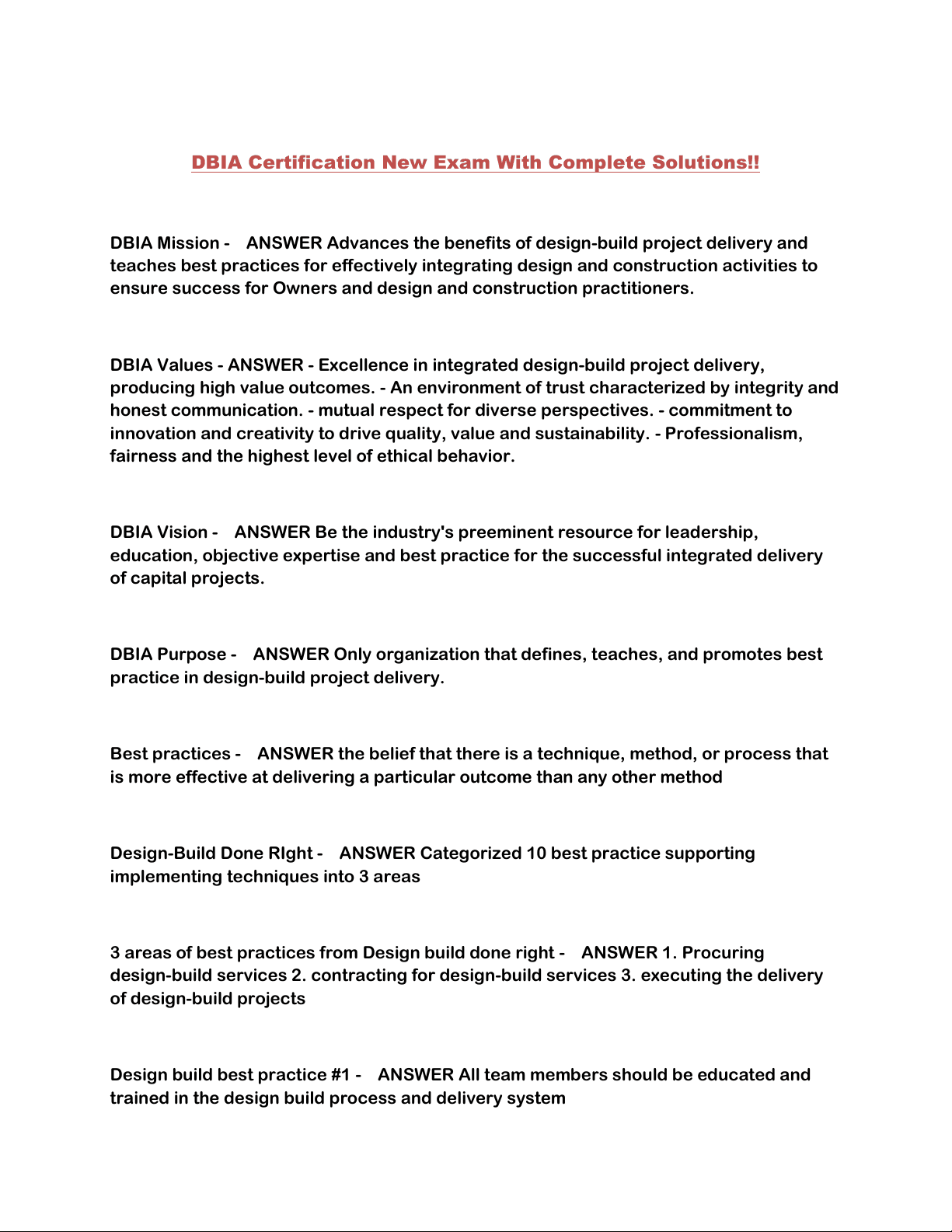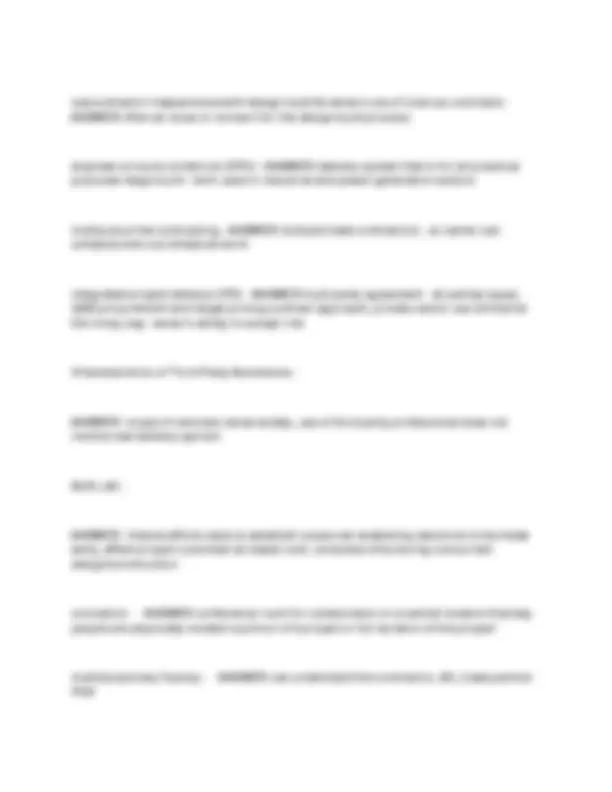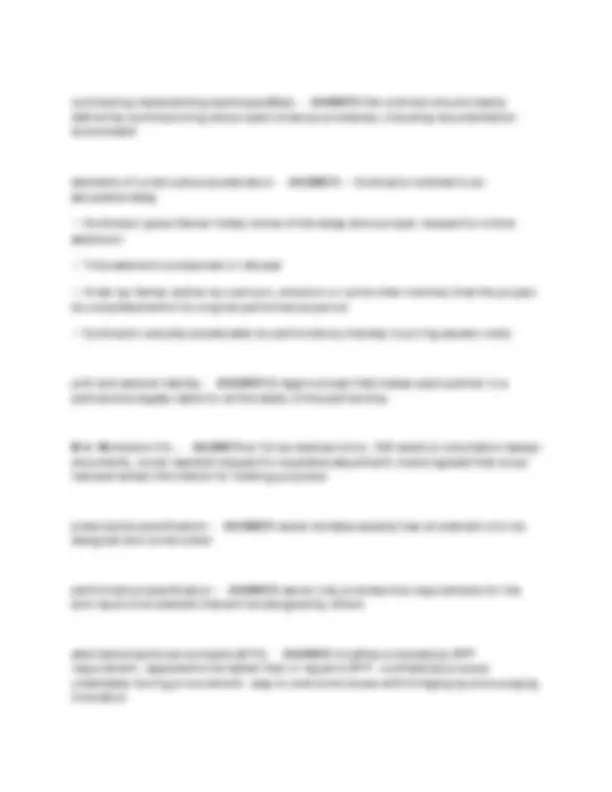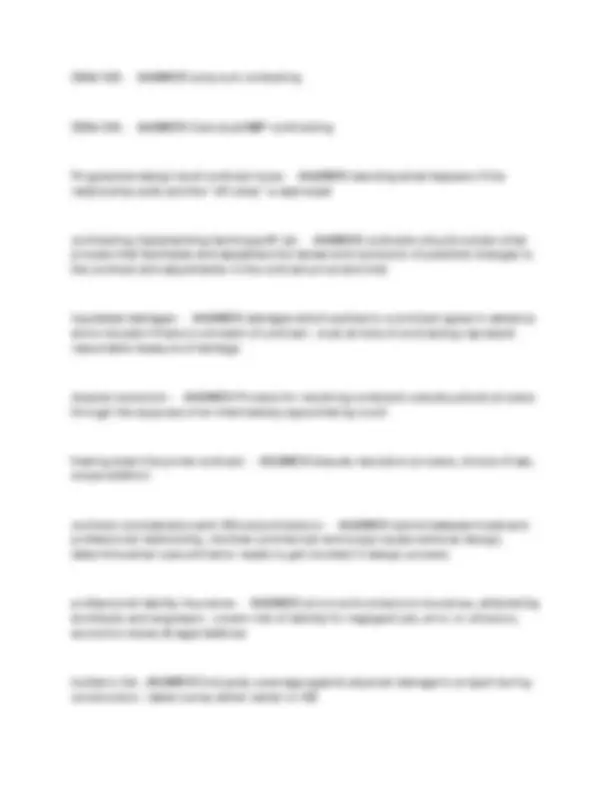











Study with the several resources on Docsity

Earn points by helping other students or get them with a premium plan


Prepare for your exams
Study with the several resources on Docsity

Earn points to download
Earn points by helping other students or get them with a premium plan
Community
Ask the community for help and clear up your study doubts
Discover the best universities in your country according to Docsity users
Free resources
Download our free guides on studying techniques, anxiety management strategies, and thesis advice from Docsity tutors
A comprehensive overview of design-build project delivery, outlining best practices and implementation techniques. It covers key aspects such as procurement, contracting, execution, and team alignment, emphasizing the importance of early involvement, qualifications-based selection, and fostering a collaborative environment. The document also explores different types of requirements, including functional, performance, and prescriptive, and discusses the role of quality assurance and quality control in ensuring project success.
Typology: Exams
1 / 17

This page cannot be seen from the preview
Don't miss anything!










DBIA Mission - ANSWER Advances the benefits of design-build project delivery and teaches best practices for effectively integrating design and construction activities to ensure success for Owners and design and construction practitioners.
DBIA Values - ANSWER - Excellence in integrated design-build project delivery, producing high value outcomes. - An environment of trust characterized by integrity and honest communication. - mutual respect for diverse perspectives. - commitment to innovation and creativity to drive quality, value and sustainability. - Professionalism, fairness and the highest level of ethical behavior.
DBIA Vision - ANSWER Be the industry's preeminent resource for leadership, education, objective expertise and best practice for the successful integrated delivery of capital projects.
DBIA Purpose - ANSWER Only organization that defines, teaches, and promotes best practice in design-build project delivery.
Best practices - ANSWER the belief that there is a technique, method, or process that is more effective at delivering a particular outcome than any other method
Design-Build Done RIght - ANSWER Categorized 10 best practice supporting implementing techniques into 3 areas
3 areas of best practices from Design build done right - ANSWER 1. Procuring design-build services 2. contracting for design-build services 3. executing the delivery of design-build projects
Design build best practice #1 - ANSWER All team members should be educated and trained in the design build process and delivery system
Key factors enabling team alignment - ANSWER Early involvement, qualifications-based selection, cost transparency, fostering an environment of trust
Core team - ANSWER Owner, lead design-builder, key specialty contractors, design and engineering professionals
post award - ANSWER The time from Notice of Award to the end of the warranty period
action steps in early involvement - ANSWER create project specific goals, 1-3 page documents for DBIA critical issues, core principals addressed in each position paper
owner - ANSWER who sets the tone for the project and is responsible for an integrated and collaborative environment
design excellence goal-ANSWER may include memorable design, state of the art structure/facility, sustainability and energy efficiency, holistic consideration of context, size and environment
integrated design and construction work plan -ANSWER task that includes all parties to get the project done in an integrated way
designer of record-ANSWER leads design effort
integrated project team leader (DB-PM)-ANSWER leads overall project team
design manager - ANSWER integrates design process with construction
5 rule of an effective constructability review - ANSWER build the project, not the problems. review the interface of various systems keep the review of preliminary documents constructive. stay focused on the important items. take the time to complete a thorough review.
procurement implementing technique #1(g) - OWNERS should know all procurement constraints imposed or flexibilities afforded by their legislative, regulatory or internal requirements
procurement implementing technique #1(c) - OWNERS should identify and involve key project stakeholders at the early stages of project planning
procurement implementing technique #1(e) - ANSWER owners should carefully research and assess current market conditions as they plan their design-build programs, as this will identify potential risks and opportunities. Potential risk includes: procurement actions that limit/expand competition, projected labor, material & equipment availability, lessons learned, and realism of budget/schedule
a project delivery system - ANSWER establishes when parties engage, determines roles of parties, influences contractual reporting relationships among parties, determines sequence, procurement, and construction, and influences responsibility for and impact of changes in the work
procurement implementing technique #1(a) - ANSWER owners should understand the potential benefits, limitations, and attributes of design-build and make an informed decision
proposal submission and contract is signed - ANSWER prior to design completion
The Spearin Doctrine - ANSWER owner hiring designers provides contractors 2 specific implied warranties: - plans and specifications are accurate, - plans and specs are suitable for the intended purpose
CMAR - ANSWER designer and contractor are under separate contracts & contractor provides preconstruction services
desing-build - ANSWER owner under on contract for both design and construction, design er and contractor have a direct relationship
subcontractor inexperience with design-build & owners use of onerous contracts - ANSWER often an issue or concern for the design build process
engineer procure contstruct (EPC) - ANSWER delivery system that is for all practical purposes deign-build - term used in industrial and power generation sectors
multipule prime contracting - ANSWER multiple trade contractors - so owner can schedule and coordinate all work
integrated project delivery (IPD) - ANSWER multi-party agreement - all parties equal, QBS procurement and target pricing contract approach, private sector use (limited at this time), key: owner's ability to accept risk
Characteristics of Third Party Assistance -
ANSWER: scope of services varies widely, use of third party professional does not involve new delivery sysrem
Shift Left -
ANSWER: intense efforts early to establish scope can enable big decisions to be made early, affect project outcomes at lowest cost; compress time during concurrent design/construction
colocation - ANSWER conference room for collaboration in a central location that key people are physically located a portion of a project or full duration of the project
multidisciplinary fluency - ANSWER can understand the contractor, AE, trade partner POV
procurement implementing technique #2(c) - ANSWER owners should develop their design-build procurement with the goal of minimizing the use of prescriptive requirements and maximizing the use of performance-based requirements
Design Details Responsibility ANS the owner should define its performance requirements and award the contract on the basis of preliminary design; this makes the design-builder responsible for completing the design in accordance with the owner's performance requirements. that also causes the design-builder to warrant the sufficiency of the design to meet the owner's criteria and the sufficiency of the design to subcontractors/suppliers that have no design responsibility
3 Types Of Requirement - ANSWER functional, performance, prescriptive
Functional Requierment -ANSWER the specific business or behavior need/user of a System
Performance Requirement- ANSWER decribes what should be done/aquired by The product or a product component or with a mesure
Prescriptive Requiremen-ANWER describes in terms of exacly how the producut ad its respective components must built
disadvantages of prescriptive requirements - ANSWER key solutions and concepts pre-determined without input or DB team, bridging subtracts from owners ability to receive a range of creative solutions, takes significant time and cost, and can shift risk and responsibility
primary qualification or selection criteria - ANSWER ability to team and focus on teamwork
shortlisting - ANSWER takes the best of "qualified" teams; a key to design-build success; not the same as prequalifying or pass/fail; keeping this small increases interest among the best teams and minimizes procurement costs for everyone including the owner
procurement implementing technique #2(f) - ANSWER owners who require project
specific technical submittals should -use two-phase procurement process -limit the requirement for such submittals to the second phase
procurement implementing technique #3 (b) - ANSWER owners should appropriately shortlist the number of proposers invited to submit proposals
solutions for procurement subjectivity - ANSWER treat all proposers fairly, establish and disclose clear evaluation and selection processes and adhere to those, and be open and transparent
proprietary meeting - ANSWER confidential meeting between designer and owner
DB procurement best practices - ANSWER limit deliverables, realistic budgets, performance based requirements, shortlisted proposers, proprietary meetings, reasonable stipends, and timely debriefing
contracting implementing technique #2(a) - ANSWER owners should evaluated and use appropriated contractual incentives
contract incentives - ANSWER 2 categories: cost & award fees - promote team success with strategic placement
Best Practice in Contracting #1 ANSWER Contracts used on design build projects should be fair, balanced, and clear, and should promote the collaborative aspects inherent in the design-build process.
Best Practice in Contracting #2 ANSWER The contract between the owner and design builder should address unique aspects of the design build process including expected standard of care for design services
best practice #3 - ANSWER the contracts between the design builder and its team members should address the unique aspects of the design build process
David Ricardo
greatly facilitated the British carry trade and rendered permissible the mutual abolition of import duties under bilateral trade treaties with other countries. - ANSWER 1823 Reciprocity of Duties
were tariffs and other trade restrictions on imported food and corn enforced in the United Kingdom between 1815 and 1846. - ANSWER Corn Laws
Corn Laws was repealed at what year? - ANSWER 1846
The 1860 treaty ended tariffs on the main items of trade — wine, brandy and silk goods from France, and coal, iron and industrial goods from Britain. - ANSWER The Cobden-Chevalier Treaty of 1860
a nondiscriminatory policy that requires countries to treat all other countries equally in regard to trade. - ANSWER MFN- most favored nation
what does MFN stands for? - ANSWER Most favored nation
what year severe depression occur? - ANSWER 1873-
In 1879, Germany would revert to more protectionist policies with its - ANSWER "iron and rye" tariff
It raised the average duty on imports to almost fifty percent, a hike designed to help shield American industries and workers from foreign competition. - ANSWER The McKinley Tariff Act of 1890
IMF? - ANSWER international monetary fund
ITO? - ANSWER international Trade Organization
arose out of the 1944 Bretton Woods Agreement. - ANSWER IMF, ITO
GATT? - ANSWER General agreement on tariffs and trade
A treaty reducing the obstacles to international trade, especially by eliminating or reducing quotas, tariffs, and subsidies. Its creation was a U.S. goal in the economic conferences during and after World War II. - ANSWER GATT 1947
how many countries signed GATT? - ANSWER 23
European Union. The Treaty would create a common market for coal and steel among its member states with freely set market prices, free movement of products, and without customs duties or taxes, subsidies, or restrictive practices. - ANSWER European Coal & Steel Community (1951)
succeeded the GATT as the global supervisor of world trade liberalization, following the Uruguay Round of trade negotiations. - ANSWER WORLD TRADE ORGANIZATION 1955
The exchange of goods and services between countries is referred to as.
In other words, it is the export and import of goods and services. - ANSWER International Trade
Selling of goods and services out of the country, - ANSWER Export
Goods and services flowing into the country. - ANSWER import
Prices or demand and supply are affected by - ANSWER global events
contracting implementing technique #2(e) - ANSWER the contract should clearly define the commissioning and project closeout processes, including documentation accossiated
elements of constructive acceleration - ANSWER ▪ Contractor entitled to an excusable delay
▪ Contractor gives Owner timely notice of the delay and a proper request for a time extension
▪ Time extension postponed or refused
▪ Order by Owner (either by coercion, direction or some other manner) that the project be completed within its original performance period
▪ Contractor actually accelerates its performance, thereby incurring excess costs
joint and several liability - ANSWER A legal concept that makes each partner in a partnership legally liable for all the debts of the partnership.
M.A. Mortenson Co. - ANSWER air force medical clinic - DB relied on solicitation design documents, corps rejected request for equitable adjustment, board agreed that corps had warranted information for bidding purposes
prescriptive specification - ANSWER owner dictates exactly how an element is to be designed and constructed
performance specification - ANSWER owner only provides the requirements for the end result of an element that will be designed by others
alternative technical concepts (ATC) - ANSWER modifies a mandatory RFP requirement - expected to be better than or equal to RFP - confidential process undertaken during procurement - way to overcome issues with bridging by encouraging innovation
DBIA 525 - ANSWER lump sum contacting
DBIA 530 - ANSWER Cost plus/GMP contracting
Progressive design build contract issue - ANSWER deciding what happens if the relationship ends and the "off-ramp" is exercised
contracting implementing technique #1 (e) - ANSWER contracts should contain a fair process that facilitates and expedites the review and resolution of potential changes to the contract and adjustments in the contract price and time
liquidated damages - ANSWER damages which parties to a contract agree in advance are to be paid if there is a breach of contract - must at time of contracting represent reasonable measure of damage
dispute resolution - ANSWER Process for resolving complaint outside judicial process through the auspices of an intermediary appointed by court
flowing down the prime contract - ANSWER dispute resolution process, choice of law, scope addition
contract consideration with DB subcontractors - ANSWER hybrid between trade and professional relationship, involves commercial and scope issues same as design, determine when subcontractor needs to get involved in design process
professional liability insurance - ANSWER errors and omissions insurance, obtained by architects and engineers - covers risk of liability for negligent act, error or omission, economic losses & legal defense
builders risk - ANSWER first party coverage against physical damage to project during construction - taken out by either owner or DB
a country should specialize its production in products in which it has a plenty of the factors of production - ANSWER Heckscher-Ohlin's Factor Endowment Theory (H-O Model)
which simply means the opposite thing to the H-O model principle i.e rich countries exporting labor intensive products and vice versa.
four stages - ANSWER introduction, growth, maturity, decline
porter's diamond - ANSWER demand condition, factor endowments, related and supporting industries, firm structure, strategy and rivalry
Grants favored trading status between two nations. By opening their markets to one another, it creates more trade and economic growth. The terms of the agreement uniform business practices and equalize the playing field.
are treaties of commerce among three or more nations. The agreements reduce tariffs and make it easier for businesses to import and export. Since they are among many countries, they are difficult to negotiate.
Free trade agreement signed between two or more countries to enable free movement of goods and services across its members' borders. The internal rules are contained in the agreement which is observed by member countries dealing with one another while for non-members, there exist external rules which the members will be putting up with. - ANSWER REGIONAL
involves the lowest level of commitment into reducing trade obstacles, though member countries do not eliminate the barriers among themselves. Also, preferential trade areas do not have common external trade barriers.
all trade barriers among members are eliminated, which means that they can move goods and services among themselves freely. In regard to dealing with non-members, the trade policies of each member still take effect.
drop trade barriers amongst themselves and assume common external trade barriers.
wherein the members drop all internal trade obstacles, adopt similar policies in terms of transacting business with those who are not the members, allow members to shift resources amongst the members without any hassle.
eliminate trade barriers among themselves, adopt common external barriers, allow free import and export of resources, adopt a set of economic policies, and use one currency.
is the final level of trading agreements.